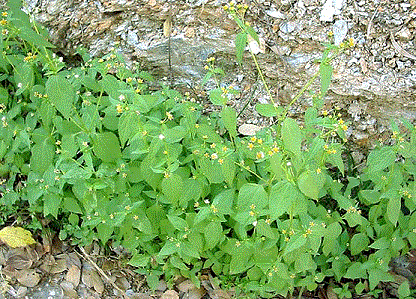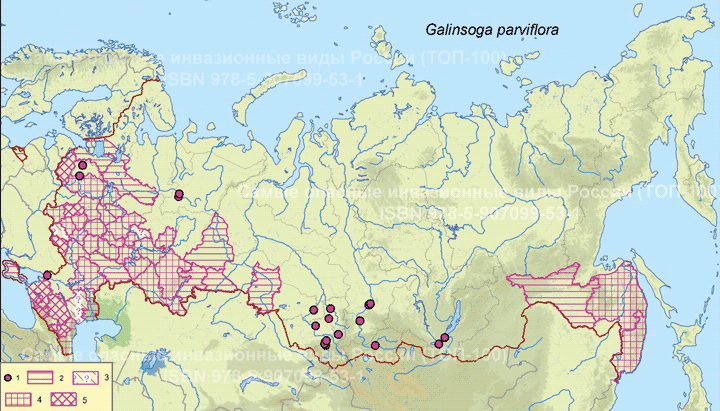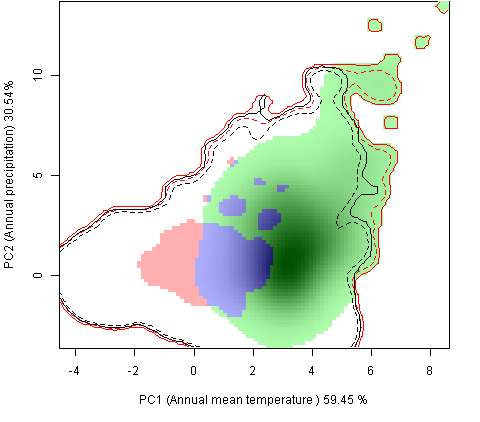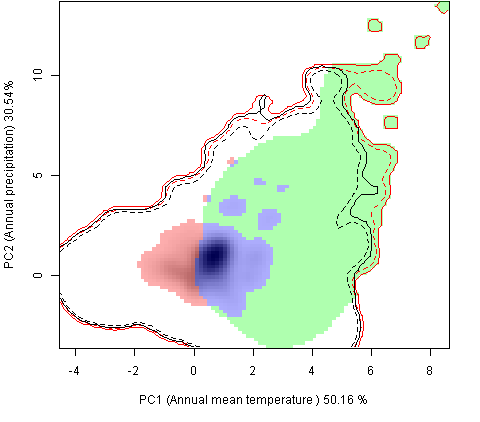 |
| |
Galinsoga parviflora Cav.
Галинзога мелкоцветковая. |
Систематическое положение (Kingdom, Phylum, Class, Order, Family, Species):
Plantae » Spermatophyta » Dicotyledonae » Asterales » Asteraceae » Galinsoga parviflora

Галинзога мелкоцветковая - Galinsoga parviflora Cav.
Русское и английское названия.
Gallant soldier, chickweed; French soldier; Peruvian daisy; quickweed; small-flower galinsoga, галинсога мелкоцветковая, галинзога мелкоцветковая.
Синонимы.
Adventina parviflora (Cav.) Raf.; Baziasa microglossa Steud; Galinsoga hirsuta Baker; Galinsoga laciniata Retz.; Galinsoga quinqueradiata Ruiz & Pav.; Sabazia microglossa DC.; Stemmatella sodiroi Hieron.; Vigolina acmella (Roth) Poir.; Wiborgia acmella Roth; Wiborgia parviflora (Cav.) Kunth.
Нативный ареал.
Северная Америка, горы Мексики.
Современный ареал (мировой и конкретнее в России).
Космополит. Северная Америка, Южная Америка, Европа, Азия, Африка, Австралия. Россия: европейская часть, Новосибирская и Томская области, Алтайский край.

Распространение и инвазионный статус галинзоги мелкоцветковой ( Galinsoga parviflora) на территории России. Инвазионный статус вида: 1 — отдельные находки, вид не натурализовался в регионе; 2 — натурализовавшийся; 3 — инвазионный статус не ясен; 4 — инвазионный, расселяется по нарушенным антропогенным местообитаниям; 5 — инвазионный, расселяется по полуестественным и естественным местообитаниям. © Проект РНФ, № 16-14-10323 (Рук. В.Г. Петросян), ИПЭЭ РАН Пути(коридоры) и векторы (способы) интродукции.
Считается, что расселилась из Ботанического сада Парижа, и Мадрида, где растение культивировалось. С 1798 года галинзога появилась в ботанических садах Германии и Швейцарии. В середине XIX века отмечена в Австрии, Польше и Италии.
В России галинзога мелкоцветковая выращивалась в ботаническом саду С.-Петербурга с 1820 года. В 1831 она была отмечена на рудеральных землях Аптекарского острова (Виноградова и др., 2011), но через некоторое время исчезла. Впоследствии повторно была введена в культуру. Взрывное расширение ареала произошло в 1980-е годы. В Средней России впервые была собрана в Нижнем Новгороде (Маевский, 1917). История расширения ареала на территории России: Московская область – 1951, Брянская – 1971, Владимирская – 1974, Татарстан - 1976, Тверская – 1977, Рязанская - 1977, Калужская – 1979, Нижегородская – 1979, Мордовия – 1983, Воронежская -область - 1983, Чувашия - 1984, Орловская область – 1984, Ивановская – 1992, Белгородская - 1995, Смоленская – 1999, Ульяновская – 1999, Пензенская – 1999, Тамбовская – 2003. Распространена также в Костромской, Липецкой, Ярославской областях. В ходе расширения вторичного ареала период от первого появления вида до натурализации сокращается: в С.-Петербурге начала дичать через 135 лет, В Латвии - через 60 лет, в Костромской области - через 10 лет, в Вологодской - всего через 3 года (Виноградова и др., 2011).
Вероятно, что занесена с американским зерном, засоренным семенами галинзоги. Семена распространяются ветром и по воде.
Местообитание.
Встречается в городах и поселках на газонах, в садах, парках, скверах, огородах, на насыпях железных и шоссейных дорог. Предпочитает рыхлые увлажненные богатые гумусом почвы. Сорняк цветников, реже засоренных газонов, встречается на железнодорожных насыпях.
Влияние вида (на другие виды, экосистемы включая лесную и агроценозы, здоровье человека).
Сорняк. Значительно заглушает морковь, петрушку, свеклу, картофель, помидоры, засоряет посевы зерновых. Злостный сорняк зерновых культур, пашен и в питомниках лекарственных растений. Обладает высокой конкурентоспособностью и быстро распространяется, что позволяет виду становиться доминантом на нарушенных местообитаниях. Является хозяином для многих насекомых, вирусов и нематод, влияющих на урожай зерновых культур (Kabuce, Priede, 2010)
В некоторых районах Центрального Черноземья внедрилась в лесные сообщества и в травостой донских лугов.
|
Графическое представление перекрывания ниш нативной и инвазионной частей ареалов, а также при сценариях изменения климата
|
|
Текущий климат
|
|
Нативная часть
|
Инвазионная часть
|
|
 A A
|
 B B
|
| Графическое представление перекрывания ниш нативной (A) и инвазионной (B) частей ареалов вида, где сиреневый цвет – зона стабильности, розовый цвет – зона расширения, зеленый цвет – зона «неиспользования». Сплошные и пунктирные линии показывают 100% и 90% области доступной среды в нативной (черные линии) и инвазионной (красные линии) частях ареалов, которые использовались для анализа перекрывания ниш. |
|
Сценарии изменения климата
|
|
RCP26
|
RCP45
|
|
 C C
|
 D D
|
|
RCP60
|
RCP85
|
|
 E E
|
 F F
|
| Графическое представление перекрывания ниш в условиях текущего климата и при сценариях его изменения - (C) RCP26; (D) RCP45; (E) RCP60; (F) RCP85. |
Литература
- Виноградова Ю.К., Майоров С.Р., Хорун Л.В. Чёрная книга флоры Средней России (Чужеродные виды растений в экосистемах Средней России). М.ГЕОС,2 010, 512 с.
- Виноградова Ю.К., Майоров С.Р., Нотов А.А. Черная книга флоры Тверской области: чужеродные виды в экосистемах Тверского региона. Москва: КМК, 2011, 292 c.
- Маевский, 1917. Флора Средней России: иллюстрированное руководство к определению среднеруских цветковых растений. 5-ое издание. Москва: изд.Сабашниковых. XXXII. 910 с.
- Папченков, Дмитриев, 1989. Новые и редкие виды заносных растений автономных республик Среднего Поволжья. Ботанический журнал. Т. 74. № 4. С. 547-553.
- Эбель А.Л., Стрельникова Т.О. Куприянов А.Н., Аненхонов О.А., Анкипович Е.С., Антипова Е.М., Верхозина А.В., Ефремов А.Н., Зыкова Е.Ю., Михайлова С.И., Пликина Н.В., Рябовол С.В., Силантьева М.М., Степанов Н.В., Терехина Т.А., Чернова О.Д., Шауло Д.Н. Инвазионные и потенциально инвазионные виды Сибири. Бюллетень Гл. Ботан. сада. 2014. Вып. 200, No1, с.52-62
- Amador Ramirez MD, 2002. Critical period of weed control in transplanted chilli pepper. Weed Research Oxford, 42(3) :203-209.
- Amin AW, Budai CS, 1994. Some weed host plants of the root-knot nematode Meloidogyne species in south-eastern Hungary. Pakistan Journal of Nematology, 12(1):59-65.
- Baltazar AM, Paller EC, Valente FV, 1980. Weed control in cabbage. Philippines, University of the Philippines at Los Banos, College of Agriculture, Department of Agronomy: Weed Science Report 1978-1979., 80-91
- Barker AV, Craker LE, 1991. Inhibition of weed seed germination by microwaves. Agronomy Journal, 83(2):302-305
- Bosque JL, Izquierdo J, 1997. Relationship between edaphic properties and weed distribution in horticultural crops along the Catalan coast. Proceedings of the 1997 congress of the Spanish Weed Science Society, Valencia, Spain, 24-26 November 1997., 255-260; 15 ref.
- Bruckart WL, Lorbeer JW, 1976. Cucumber mosaic virus in weed hosts near commercial fields of lettuce and celery. Phytopathology, 66(3):253-259
- Cabrera AL, 1963. Flora de la Provincia de Buenos Aires. Parte VI. Compuestas. Buenos Aires, Argentina: Coleccion Cientifica del INTA.
- Canne JM, 1983. Cytological and morphological observations in Galinsoga and related genera (Asteraceae). Rhodora, 85:355-366.
- Cantele A, Zanin G, Zuin MC, 1984. Evolution of the weed flora of maize in Friuli (northeast Italy) and the part played by monoculture. Comptes rendus du 7eme colloque international sur l'ecologie, la biologie et la systematique des mauvaises herbes Paris, France; COLUMA/EWRS, Vol.1:437-447
- Chandra SK, 2012. Invasive Alien Plants of Indian Himalayan Region- Diversity and Implication. American Journal of Plant Sciences, 3:177-184.
- Choroszewski P, 1994. Infestation of potato cultures with weeds in Poland. Ochrona Roslin, 38(7):9-11
- Corre WJ, 1983. Growth and morphogenesis of sun and shade plants. III. The combined effects of light intensity and nutrient supply. Acta Botanica Neerlandica, 32(4):277-294
- Davidse G, Sousa-Pena M, Knapp S, Chiang Cabrera F, 2014. Asteraceae. 5(2). In: Flora Mesoamericana [ed. by Davidse, G. \Sousa Sanchez, M. \Knapp, S. \Chiang Cabrera, F.]., Mexico: Universidad Nacional Autonoma de Mexico.
- Gao GY, Boggs JF, Bennett PJ, Martin JC, Chatfield JA, Rose MA, Rimelspach JW, Zondag RH, Street JR, Pound WE, 1999. Weed problems in Ohio turf, landscapes, and nurseries: 1998. Special Circular - Ohio Agricultural Research and Development Center, No. 165:55-58; 4 ref.
- Garcia Blanco H, 1983. Competition period of a natural community of dicotyledenous weeds on lettuce (Lactuca sativa L.). Biologico, 49(9/10):247-252
- Garcia M XR, 1985. Some contributions to the Galician flora. Anales del Jardin Botanico de Madrid, 42(1):191-196
- Gofflot A, Verhoyen M, 1990. Speedy development of tomato spotted wilt virus infection transmitted by Frankliniella occidentalis in ornamental greenhouse cultivars in Belgium. Parasitica, 46(2-3):85-88
- Gracia O, Feldman JM, 1989. First report of tomato spotted wilt virus on celery and three weed species in Argentina. Plant Disease, 73(10):859
- Greve L, 2001. Dioxyna bidentis (Robineau-Desvoidy, 1830) (Diptera, Tephritidae) new to Norway. Norwegian Journal of Entomology, 48(2):250; 4 ref.
- Hegewald HB, 1982. Species composition and nutrient content of weeds in grain maize 1977. Angewandte Botanik, 56(3/4):279-281
- Holm LG, Pancho JV, Herbenger JP, Plucknett DL, 1979. A Geographical Atlas of World Weeds. New York, USA: John Wiley & Sons.
- Hulina N, 1978. The weed association Panico-Galinsogetum Tx ex Becker 1942 in Turopolje Region. Fragmenta Herbologica Jugoslavica, 6(106-115):73-79
- Kabuce, N. and Priede, N. (2010): NOBANIS – Invasive Alien Species Fact Sheet – Galinsoga quadriradiata. – From: Online Database of the European Network on Invasive Alien Species – NOBANIS www.nobanis.org, Date of access x/x/201x.
- Konstantinov KA, Nikolova V, 1983. Changes in the weed associations of the main vegetable crops. Gradinarska i Lozarska Nauka, 20(5):82-89
- Kranz WR, Vieira C, Cardoso AA, Reis MS, 1982. Effects on bean (Phaseolus vulgaris L.) cultivars of weed competition. Anais, I reuniao nacional de pesquisa de feijao. Centro Nacional de Pesquisa-Arroz, Feijao Goiania Brazil, 224-225
- Laca-Buendia JP, Brandao M, 1994. Survey and quantitative analysis of weeds occurring in coffee plantations in areas formerly occupied by cerrado in Triangulo Mineiro and Alto Paranaiba. Daphne, Revista do Herba^acute~rio PAMG da EPAMIG, 4(4):71-76; 13 ref.
- Link D, Severo Pedrolo S, 1987. Biological aspects of Agrotis ipsilon (Hufnagel, 1767) at Santa Maria-RS. Revista do Centro de Ciencias Rurais, 17(4):309-317; [4 fig.]; 7 ref.
- Liogier HA, 1997. Descriptive flora of Puerto Rico and adjacent Islands: Spermatophyta-Dicotyledoneae Vol. 5: Acanthaceae to Compositae. Puerto Rico: Editorial de la Universidad de Puerto Rico.
- Liu Jian, Dong Ming, Miao SL, Li ZhenYu, Song MingHua, Wang RenQing, 2006. Invasive alien plants in China: role of clonality and geographical origin. Biological Invasions, 8(7):1461-1470.
- Lordello RRA, Lordello AIL, Paulo EM, 1988. Reproduction of Meloidogyne javanica in weeds. Paper presented at the XII Brazilian Nematology Congress held at Dourados, MS, Brazil from 1-5 Feb. Lab. Nematol., IAC, Caixa Postal 28, 13001, Campinas, SP, Brazil. Nematologia Brasileira, 12:84-92.
- Lorenzi H, 1982. Weeds of Brazil, terrestrial and aquatic, parasitic, poisonous and medicinal. (Plantas daninhas de Brasil, terrestres, aquaticas, parasitas, toxicas e medicinais.) Nova Odessa, Brazil: H. Lorenzi, 425 pp.
- Lorenzi H, 1986. Plantas daninhas do Brasil. Centro de Tecnologia Copersucar.
- Maina JM, Thuranira EG, Kibata GN, Musembi FJ, Nyanyu G, Muthamia JGN, Okuro JO, Mutura I, Amboga S, Micheni AN, Mureithi F, Overfield D, Terry PJ, 2001. Participatory development of weed management strategies in maize based cropping systems in Kenya. The BCPC Conference: Weeds, 2001, Volume 1 and Volume 2. Proceedings of an international conference held at the Brighton Hilton Metropole Hotel, Brighton, UK, 12-15 November 2001, 199-204; 13 ref.
- Martinez D G, Medina P J, Tasistro S A, Fischer C A, 1983. Methods of controlling weeds in maize, Zea mays; effect of control methods, density and distribution of the crop. Revista Chapingo, 8(40):83-89
- Mertelfk J, G?tzov? B, Mokr? V, 1996. Epidemiological aspects of tomato spotted wilt virus infection in the Czech Republic. Acta Horticulturae, No. 432:368-375; 13 ref.
- Mitidieri A, Bianchini PR, 1973. Herbicide evaluation for weed control in spinach, spinach beet and red beet. Informe Tecnico, Estacion Experimental Agropecuaria San Pedro, Argentina, No. 14:14 pp.
- Mito T, Uesugi T, 2004. Invasive alien species in Japan: the status quo and the new regulation for prevention of their adverse effects. Global Environmental Research, 8(2):171-191.
- Mondin CA, 2014. Galinsoga in Lista de Especies da Flora do Brasil (Galinosoga in the list of species of the flora of Brazil). Rio de Janeiro, Brazil: Jardim Botanico do Rio de Janeiro. http://reflora.jbrj.gov.br/jabot/floradobrasil/FB104151
- Montenegro-Galvez V, Criollo-Escobar H, 1978. The effect of competition between cool climate Phaseolus beans cv. Diacol Andino and weeds. Revista de Ciencias Agricolas, 8(1/14):26-34
- Moyer JR, Owenya ZJ, Kibuwa SP, 1989. Weed populations and agronomic practice at wheat farms on the Hanang plains in Tanzania. Tropical Pest Management, 35(1):26-29; 9 ref.
- Muminovic S, 1990. Competitive effects between weeds and crops in the field. Fragmenta Herbologica Jugoslavica, 19(2):103-116
- Murray L, 1992. Galinsoga parviflora Cav. New South Wales Flora Online. Nagaraju, Muniyappa V, Singh SJ, Virupakshappa K, 1997. Occurrence of a mosaic virus disease on sunflower in Karnataka. Indian Phytopathology, 50(2):277-281; 8 ref.
- Nagaraju, Muniyappa V, Singh SJ, Virupakshappa K, 1997. Occurrence of a mosaic virus disease on sunflower in Karnataka. Indian Phytopathology, 50(2):277-281; 8 ref.
- Nankar JT, Singh M, Mukhtar Singh, 1981. Weed flora in relation to season and location and economics of weed control in potato in the hills and plains of north-western India. In: Proceedings of the Eighth Asian-Pacific Weed Science Society Conference, 1981. Parbhani, India: Dep. Agron., Marathwada Agric. Univ., 79-83.
- Neogi B, Rao RR, 1980. Floristic composition of the weed flora, seasonal variation and phenology of some weeds of agriculture lands in Khasi Hills, Meghalaya. Proceedings of the Indian National Science Academy, B, 46(4):579-586
- Ngongo M, Lunze L, 2000. Dominant plant species as indices of soil productivity and the response of common bean and application of compost. African Crop Science Journal, 8(3):251-261; 42 ref.
- Orchard AE, 1994. Flora of Australia. Vol. 49, Oceanic islands 1. Canberra, Australia: Australian Government Publishing Service.
- Owenya ZJ, Makoko BR, Moyer JR, 1987. Weed populations and cultural practices on wheat farms of the Hanang complex in Tanzania. Fifth Regional Wheat Workshop for Eastern, Central and Southern Africa and the Indian Ocean., 209-214; 6 ref.
- Pandey AK, Prakash V, Singh RD, Mani VP, 2002. Studies on crop-weed competition and weed dynamics in maize under mid-hill conditions of N-W Himalayas. Indian Journal of Weed Science, 34(1/2):63-67; 7 ref.
- Pandza M, Franjic J, Trinajstic I, Skvorc Z, Stancic Z, 2001. The most recent state of affairs in the distribution of some neophytes in Croatia. Natura Croatica, 10(4):259-275.
- Paradkar V, Tiwari JP, Yadav SK, 2002. Survey of weeds in semi irrigated and irrigated wheat of satpurazone of Madhya Pradesh. Bharatiya Krishio Anusandhan Patrika, 17:2-3, 99-105.
- Prete CEC, Nunes Junior J, Menten JOM, 1984. Fungi associated with weed seeds. Summa Phytopathologica, 10(3/4):260-267; 19 ref.
- Pysek P, Sadlo J, Mandak B, 2002. Catalogue of alien plants of the Czech Republic. Preslia, 74(2):97-186.
- Rai JPN, Tripathi RS, 1984. Population dynamics of different seedling cohorts of two co-existing annual weeds, Galinsoga ciliata and G. parviflora, on two contrasting sites. Acta Oecologica, Oecologia Plantarum, 5(4):357-368
- Rai JPN, Tripathi RS, 1985. Effect of herbivory by the slug, Mariaella dussumieri, and certain insects on growth and competitive success of two sympatric annual weeds. Agriculture, Ecosystems and Environment, 13(2):125-137; [4 fig.].
- Rai JPN, Tripathi RS, 1986. Effects of density and soil nitrogen levels on growth of Galinsoga quadriradiata and G. parviflora in pure and mixed stands. Canadian Journal of Botany, 64(11):2708-2715
- Rai JPN, Tripathi RS, 1986. Population regulation of Galinsoga ciliata (Raf.) Blake and G. parviflora Cav.: effect of 2,4-D application at different growth stages and light regimes. Weed Research, UK, 26(1):59-67
- Rai JPN, Tripathi RS, 1987. Germination and plant survival and growth of Galinsoga parviflora Cav. as related to food and energy content of its ray- and disc-achenes. Acta Oecologica, Oecologia Plantarum, 8(2):155-165
- Rana SS, 2002. Evaluation of promising herbicide combinations for weed management in rajmash (Phaseolus vulgaris L.) under dry temperate conditions of Himachal Pradesh. Indian Journal of Weed Science, 34(3/4):227-230; 4 ref.
- Russo S, GimTnez RA, Rodrfguez SM, Della Penna AB, 2001. Interactions among the cultivations of oats and wheat, weeds, aphids and predators. IDESIA, 19(1/2):7-16; 16 ref.
- Safonov GE, 1992. An addition to the flora of the Astrakhan region. Botanicheskii Zhurnal, 77(5):60-61
- Schmidt RR, 1986. Studies on the influence of different rotational crops and herbicidal treatments on weed flora and crop plants. Pflanzenschutz-Nachrichten Bayer, 39(3):246-344
- Schwerzel PJ, Thomas PEL, Oosterman HM, Lindert HJA van, 1979. The influence of weeds on yield parameters of teff (Eragrostis tef (Zucc.) Trotter) and wheat (Triticum turgidum (L.) Thell. var. durum (Desf.) Mac.Key) with different levels of nitrogen fertilizer. Annual report 1977-78.
- Shukla DD, Shanks GJ, Teakle DS, Behncken GM, 1979. Mechanical transmission of galinsoga mosaic virus in soil. Australian Journal of Biological Sciences, 32(2):267-276
- Singh RV, Arya MPS, 1999. Integrated weed management in barnyard millet. Annals of Agricultural Research, 20(1):35-38; 3 ref.
- Singh RV, Arya MPS, 1999. Integrated weed management in fingermillet (Eleusine coracana). Indian Journal of Agronomy, 44(3):571-575; 4 ref.
- Slonovschi V, 1982. Contributions to the knowledge of grades of weediness in agricultural crops on the Moldavian Plain. Cercetari Agronomice in Moldova, No.2:148-152
- Srikanth J, Mallikarjunappa S, Kumar P, Reddy GVP, 1988. Record of new hosts for lantana bug. Current Research - University of Agricultural Sciences (Bangalore), 17(5):60-61; 10 ref.
- Stalder L, 1978. Report of activities 1978 Swiss Canning Industry. Trials on chemical weed control in beetroot, Swiss chard, asparagus, beans and spinach. Tatigkeitsbericht 1978 zu Handen der schweizerischen Konservenindustrie. Versuche zur chemischen Unkrautbekampfung in Randen, Mangold, Grunspargeln, Bohnen und Spinat., 20 pp.
- Steden C, Schulte M, 2000. Eclat - mode of action and experiences in tank mixtures for weed control in maize. Zeitschrift fu^umlaut~r Pflanzenkrankheiten und Pflanzenschutz, Sonderh. 17:683-688; 4 ref.
- Sun EJ, Huang MH, 1995. Detection of peroxyacetyl nitrate at phytotoxic levels and its effects on vegetation in Taiwan. A&WMA International.
- Tao JF, Qin Y, 1987. Taxonomic studies on the genus Plasmopara of China III. New species, new combination and new record of Plasmopara on family Compositp. Acta Mycologica Sinica, 6(2):65-73
- Terry PJ, Michieka RW, 1987. Common Weeds of East Africa. Rome, Italy: Food and Agriculture Organization of the United Nations.
- Tessema T, Lemma Y, Admasu B, 1999. Qualitative and quantitative determination of weed occurrence in wheat in West Shewa Zone of Ethiopia. Proceedings of the Tenth Regional Wheat Workshop for Eastern, Central and Southern Africa, University of Stellenbosch, South Africa, 14-18 September, 1998., 160-172; 12 ref.
- Thomas PEL, Schwerzel PJ, 1979. Weed competition in Rhodesian wheat. Rhodesia Agricultural Journal, 76(2):73-75
- Thomas PEL, Schwerzel PJ, Lindert HJA van, 1978. Competition studies .Henderson Res. Sta., Salisbury, Rhodesia.
- Toit AEJ du, Court de Billot MRle, 1991. Weed emergence patterns of some arable weeds under field conditions. South African Journal of Plant and Soil, 8(3):153-157
- Toskov K, Dimitrova M, 2002. Effectiveness and selectivity of some herbicides on tomatoes from in-house propagation. Bulgarian Journal of Agricultural Science, 8(2/3):223-228; 12 ref.
- Ugen MA, Wien HC, Wortmann CS, 2002. Dry bean competitiveness with annual weeds as affected by soil nutrient availability. Weed Science, 50(4):530-535; 24 ref.
- Urban I, 1920. Symbolae Antillanae,seu, Fundamenta florae Indiae Occidentalis, Volume 8.
- Usami Y, 1976. Ecological studies on weeds in mulberry fields. 2. Auto-ecology of Galinsoga parviflora Cav. Weed Research, Japan, 21(2):76-80
- USDA-ARS, 2014. Germplasm Resources Information Network (GRIN). Online Database. Beltsville, Maryland, USA: National Germplasm Resources Laboratory. https://npgsweb.ars-grin.gov/gringlobal/taxon/taxonomysearch.aspx
- Wagner WL, Herbst DR, Sohmer SH, 1999. Manual of the flowering plants of Hawaii. Revised edition. Honolulu, Hawaii, USA: University of Hawaii Press/Bishop Museum Press, 1919 pp.
- Warwick SI, Sweet RD, 1983. The biology of Canadian weeds. 58. Galinsoga parviflora and G. quadriradiata (= G. ciliata). Canadian Journal of Plant Science, 63(3):695-709
- Waterhouse DF, 1993. The Major Arthropod Pests and Weeds of Agriculture in Southeast Asia. ACIAR Monograph No. 21. Canberra, Australia: Australian Centre for International Agricultural Research, 141 pp.
- Waterhouse DF, 1993. The Major Arthropod Pests and Weeds of Agriculture in South-East Asia. Canberra, Australia: Australian Centre for International Agricultural Research.
- Wegorek K, Lipa JJ, eds., 1979. Poznan, Poland: Proceedings of the XIX Conference of The Scientific Institute of Plant Protection, 267-278.
- Wiesner K, Haberland R, 1980. Population density and species spectrum of surviving weeds in sugar-beet crops. Archiv fur Phytopathologie und Pflanzenschutz, 16(3):217-226
- Wu TL, 2001. Check List of Hong Kong Plants. Agriculture, Fisheries and Conservation Department Bulletin 1 (revised):384 pp.
- Zagonel J, VenGncio WS, Kunz RP, 2000. Effect of methods and control time of weeds in maize crop. Planta Daninha, 18(1):143-150; 12 ref.
- Zajac M, Zajac A, 2001. Success factors enabling the penetration of mountain areas by kenophytes: an example from the Northern Polish Carpathians. Plant invasions: species ecology and ecosystem management, 271-279; 17 ref.
- Zawirska I, 1979. Studies on the tobacco thrip (Thrips tabaci Lind.) and its role in the transmission of tomato spotted wilt virus (TSWV) on tobacco. In: Wegorek W, Lipa JJ, ed. Proceedings of the XIX Conference of the Scientific Institute of Plant Protection.: Materialy XIX Sesji Naukowej Instytutu Ochrony Roslin. Panstwowe Wydawnictwo Rolnicze i Lesne Oddzial w Poznaniu. Poznan Poland, 267-278
- Zinikeviciute D, Baleliunas P, 1998. Efficiency of Butisan S for white head cabbage and cauliflower. Z^hacek~emdirbyste^dot over~, Mokslo Darbai, 62:53-62; 10 ref.
- Zorilla RA, Davide RG, 1983. Host range, development and survival of the potato cyst nematode, Globodera rostochiensis, Woll., on potato in the Philippines. Philippine Agriculturalist, 66(4):439-447.
- Zweep AT, Ast Avan, 1990. The influence of red/far red ratios of light and of a plant cover on the germination of some weed species. Mededelingen van de Faculteit Landbouwwetenschappen, Rijksuniversiteit Gent, 55(36):1029-1217
Другие ссылки
EPPO, 2014. PQR database. Paris, France: European and Mediterranean Plant Protection Organization.
DAISIE, 2014. Delivering Alien Invasive Species Inventories for Europe. European Invasive Alien Species Gateway.
USDA-NRCS, 2014. The PLANTS Database. Baton Rouge, USA: National Plant Data Center.
PIER, 2014. Pacific Islands Ecosystems at Risk. Honolulu, USA: HEAR, University of Hawaii.
|





